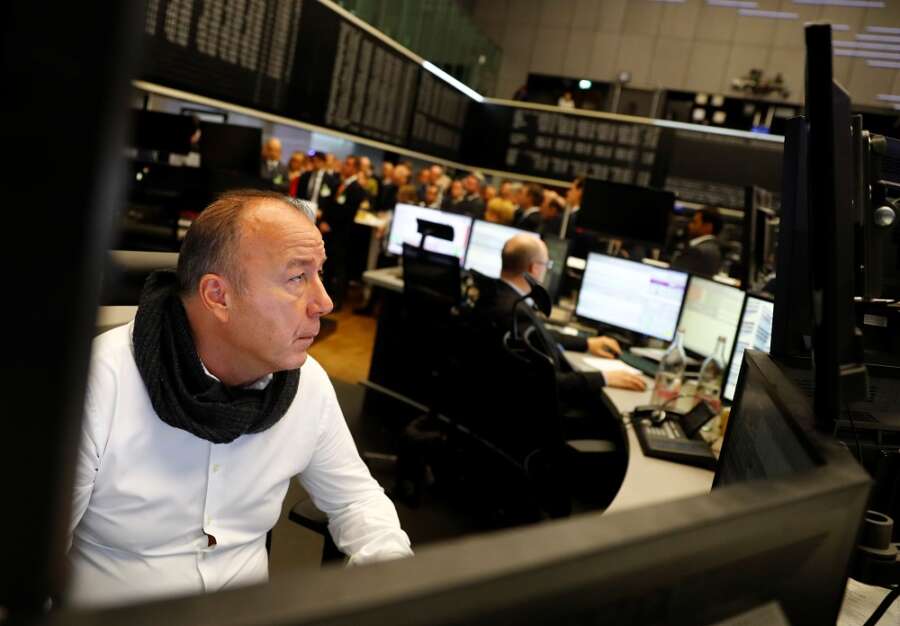
By Danilo Masoni
MILAN (Reuters) – World shares turned lower on Wednesday and bond yields shot up after U.S. data showed inflation there slowed down less than expected last month, cementing expectations of aggressive rate hikes by the Federal Reserve.
U.S. futures turned negative after data showed U.S. annual consumer price growth slowed to 8.3% in April from 8.5% in March, suggesting that inflation has probably peaked. The number, however, was above the 8.1% analyst had expected.
Paolo Zanghieri, senior economist at Generali Investments, said the data confirmed the view that the return of inflation to more tolerable values will take time.
“Overall today’s data add to the case of the strong front-loading called for by (|Fed Chair Jerome) Powell in the last meeting, who also suggested the possibility of two more 50bps rise in June and July,” Zanghieri said. “However, this will keep concern on the possibility of a recession high, and ultimately weakening growth may lead the Fed to temper it tightening after the summer.”
MSCI’s benchmark for global stocks was flat by 1247 GMT, having earlier risen as much as 0.3%. On Tuesday, the index fell to its lowest level since November 2020 on fears Fed tightening could significantly slow down the global economy.
U.S. equity futures turned sharply negative, with the Nasdaq and S&P 500 e-minis down 1% and 0.6% respectively. The pan-European STOXX 600 equity benchmark index also trimmed gains, and was last up 0.2%.
Money markets ramped up bets of Fed rate hikes by end-2022 to 208 basis points after the U.S. inflation numbers, compared to around 195 bps before.
Earlier in Asia, equities squeezed higher from near two-year lows. Chinese blue chips rose 1.4% after Shanghai officials said half the city had achieved “zero COVID” status, and after U.S. President Joe Biden said he was considering eliminating Trump era tariffs on China.
Chinese data released on Wednesday, however, showed consumer prices rose 2.1% from a year earlier, more than expected and at the fastest pace in five months, partly due to food prices.
YIELDS SHOOT UP
After falling to their lowest levels in almost a week earlier on Wednesday, benchmark 10-year Treasury yields turned positive after the inflation data, marching back towards the three-year high of 3.203% hit on Monday.
The 10-year yield was last up 6 basis points on the day to 3.0502%, while the 2-year yield, which often reflects the Fed rate outlook, jumped 11 bps to 2.717%.
Euro area government bond yields also sold off following the U.S. data, sending German 10-year yields up 8 bps to 1.084%.
Bets over aggressive Fed tightening have also supported the dollar this year.
The dollar index, which measures its performance against six main peers, reversed earlier weakness and was last up 0.1% to 104.04, closer to the two-decade high of 104.19 reached at the start of the week.
The Fed last week raised interest rates by 50 basis points and Chair Jerome Powell said two more such hikes were likely at the upcoming policy meetings.
There has also been speculation in markets the U.S. central bank will need to move by 75 basis points at one meeting and currently money markets are pricing over 190 basis points of combined rate hikes by year.
“The current problem is that the market is convinced that the Fed is determined to fight inflation and therefore willing to tolerate market volatility and some demand destruction more than in the past. Personally, I’m less convinced of this determination,” said Giuseppe Sersale, fund manager at Anthilia.
Morgan Stanley forecasts 2022 global economic growth to be less than half of last year’s at 2.9%, down from a previous estimate of 3.2%. The U.S. bank also cut its year-end target for the S&P 500 by 11% to 3,900 points, while raising its U.S. 10-year yield forecast by 55 bps to 3.15%.
Oil bounced back, buoyed by supply concerns as the European Union works on gaining support for a ban on Russian oil. [O/R]
Brent rose 2.6% to $105.12 a barrel and U.S. crude rose 3% to $102.77.
Spot gold dipped 0.1% to $1,836.2 an ounce.
(Reporting by Danilo Masoni in Milan, Sujata Rao in London and Alun John in Hong Kong, Editing by William Maclean and Tomasz Janowski)


